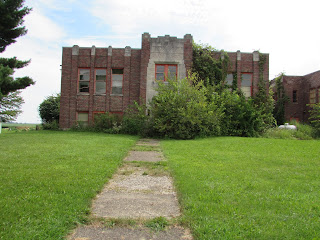A
short road trip found Spence and myself spending a night in Lock Haven,
Pennsylvania. After spending the day roaming rural Pennsylvania, checking out
the Pennsylvania Grand Canyon and the Wellsboro Diner, we headed for an evening
of baseball
and adventure. In our brief time in the area, we found good food, conversation
and interesting things to think about.
 |
| A home for the night |
Sometimes
the adventure of travelling is not limited to where one visits, but often where
one lays their head. This trip had us staying in a caboose, constructed by the
Pennsylvania Railroad in 1941. It is now owned and operated as B&B (without
the breakfast) by the Clinton
County Historical Society. The caboose rests at the old railroad station in
Castanea, a small village just across Bald Eagle Creek from Lock Haven. It had the
amenities of a nice self-service hotel room, with a dining area, refrigerator
and microwave, plus the added bonus of great nostalgia. Although trains no
longer pass through the small village, and most of the tracks have long since
disappeared, as you wake up one can still hear a constant stream of train
whistles in the distance, punctuating the quiet early morning. At one point I
thought to myself, is this what it would be like to ride the rails?
A
minor problem with staying in the caboose was that I did not bring a towel,
something not provided by the historical society. Thinking I might like to have
a shower the next morning, we stopped by a dollar store to purchase a lime
green towel ($2.50) and matching washcloth (.50). The next morning, after
taking a shower, it seemed that the towel had left a great deal of itself on
the floor of the shower. The rest of the day I felt like I was picking lime
green lint out of my hair and off my clothes.
 |
| A bed for the night |
My
travelling partner has a propensity to sleep late, so I took the opportunity to
have a short walk to explore Castanea. After a night of rain, clouds hung low
over the mountains as I walked. The town has become a bedroom community of
working-class people, with older homes and very few businesses. There was one
house, at the corner of Logan and Brown, which has been abandoned for some time
that made me think of the old mansion in the film, It’s A Wonderful Life. Not that the house necessarily resembled
the abandoned film mansion; however, the broken windows and the two stories made
me wonder if local people might believe the house was haunted. The streets in
the town resemble the lattice-work of a pie top, nestled between Bald Eagle Mountain
and Bald Eagle Creek. A small, fast-flowing stream, Harvey’s Run, bisects the
town from the mountain to the creek. It was running quite heavy after a night
of rain.
After
my perambulation I find myself at the Train Station Restaurant, a thriving
enterprise. The restaurant occupies what once was a house. Two women ran the
breakfast without pretense. The food was simple but good and informal. An egg,
toast and a cup of coffee cost me less than $4.00, meanwhile I was privy to
many of the conversations between locals. The waitress kindly laughed at my
joke that I might be back for a second breakfast when Spencer woke up. Sure
enough, about 45 minutes later, we returned to the restaurant and I had yet
another cup of coffee and toast while Spence had a hearty breakfast of waffle
and bacon.



